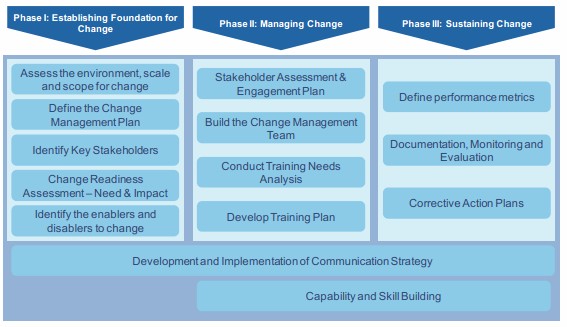Change management is the methodology that integrates change and the ability to adapt into the organization. It is an organized, systematic application of the knowledge, tools, and resources of change that provides organizations with a key process to achieve their basic business strategy. This will involve training of the personnel at all levels, more so, at the lower rung of government management organizations.
Change management is an approach to shifting / transitioning individuals, teams and organizations from a current state to a desired future state.
It is an organizational process aimed at helping change stakeholders to accept and embrace changes in their business environment. In some project management contexts, change management refers to a project management process wherein changes to a project are formally introduced and approved.
Change management as the utilization of basic structures and tools to control any organizational change effort. Change management’s goal is to maximize an organization’s benefits and minimize the change impacts on workers and avoid distractions. Some of the Organizational changes can be listed as
- Mission changes
- Strategic changes
- Operational changes (including Structural changes)
- Technological changes
- Changing the attitudes and behaviors of personnel.
In a Government department organizational change management should begin with a systematic diagnosis of the current situation in order to determine both the need for change and the capability to change. The objectives, content, and process of change should all be specified as part of a Change Management plan.
Organizational change management aligns groups’ expectations, communicates, integrates teams and manages people training. It makes use of performance metrics, such as financial results, operational efficiency, leadership commitment, communication effectiveness, and the perceived need for change to design appropriate strategies, in order to avoid change failures or resolve troubled change projects.
Need – The implementation of e-Governance programs brings along drastic changes in the routine functioning of day to day government. There are changes in the processes, reporting structure, delegation of powers, administrative set-up, roles and responsibilities of the employees etc. Hence, implementation of E-Government programs necessitates change management.
Usage – Change management is often added after the project begins to experience problems. In reality, in most of the E-Government projects we see that change management processes are initiated only after the project implementation has started. This initiative again is mostly not taken with a holistic understanding of change management, and is taken as a reactive measure rather than pro-active measure.
The change management process activities should be included as part of the project plan. It should be developed by an in house team having the required level of competency, and recommended to be facilitated by an external consultant team. Achieving successful change management with e-Governance requires you to use both individual and organizational change management approaches.
Key components – Key components of successful change management are:
- Leadership
- Focused and coherent strategy, including defined objectives and implementation plans;
- Buy-In from stakeholders, which includes
- Consultation;
- Incentives;
- Training; and
- Monitoring and evaluation.
Effective Communication – It is crucial for change management as
- Organisational Change cannot occur without communication
- Communication is not a single step or component of a change process – it must occur in parallel, fully integrated with the change process
- Communication is not something done to a target audience, but effective communication is a two-way process, focused on dialog
- Communication professionals also apply the rigorous planning process, assessing stakeholder needs, creating and coaching message delivery, and building feedback loops
Phases of Change Management – Change Management involves three phases as
- Establishing Foundation for Change (Phase I) – It involves assessing the scale of change in terms of number of affected entities, users, geographical spread, etc., assessing the scope in terms of policy, process, system and structure, assessing the existing environment to understand ‘change readiness’ and ‘culture’ , preparing a change management plan , identifying the key stakeholders, in terms of people impacted and those capable of and identifying the key enablers and disablers of change
- Managing Change (Phase II) – It involves mapping of various stakeholders and stakeholder groups, building the change management team, defining the roles and responsibilities of the members of the change team, doing training needs analysis and preparing the training plan for addressing the training needs
- Sustaining Change (Phase III) – It consist of identifying the performance metrics for measuring the success of ‘Change’ and monitoring and evaluating the metrics


